ホーム > 教育・文化・スポーツ > 文化・芸術 > 文化財保護 > “Kamakura”- Aiming for Registration as a World Heritage Site > Cultural Properties of “Kamakura, Home of the Samurai”
更新日:2024年11月6日
ここから本文です。
Cultural Properties of “Kamakura, Home of the Samurai”
This page informs of designated cultural properties of
Cultural Properties of "Kamakura, Home of the Samurai"
(Click the below properties for more details.)
(1)Tsurugaoka Hachimangu Shrine/Wakamiya Oji Avenue, (2)Egara Tenjinsha Shrine, (3)Jufukuji Temple,
(4)Kenchoji Temple, (5)Engakuji Temple, (6)Zuisenji Temple, (7)Daibutsu (Great Buddha) of Kamakura,
(8)Kakuonji Temple, (9)Jokomyoji Temple, (10)Gokurakuji Temple, (11)Shomyoji Temple,
(12)Yofukuji Temple Site, (13)Hokkedo Buddha Hall Site, (14)Toshoji Temple Site, (15)Buppoji Temple Site,
(16)Hojo Tokiwa Residence Site, (17)Wakaenoshima Port
(18)Passes((18)-1Asaina Kiridoshi, (18)-2Nagoe Kiridoshi, (18)-3Kamegayatsuzaka, (18)-4Kewaizaka,
(18)-5Daibutsu Kiridoshi)
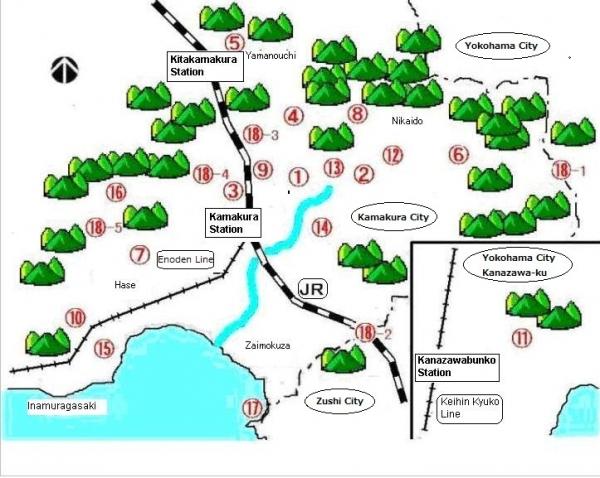
(Numbers in the map show the approximate locations of the properties, and doesn't indicate the area designated as the cultural properties. )
(1) Tsurugaoka Hachimangu Shrine/Wakamiya Oji Avenue
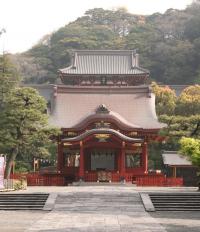
In 1180, Tsurugaoka Hachimangu was constructed at the current site by ”Minamoto-no-Yoritomo” and worshiped as a Guardian of the government and also regarded as the center axis of Kamakura together with "Wakamiya Oji" avenue.
In the compound and near the "Wakamiya Oji Avenue", there are important cultural properties such as shrines of "Sessha Wakamiya", "Uemiya", and "Otorii "shrine gate.
Cultural properties designated by the national government (Historic sites)
- The compound of Tsurugaoka Hachimangu Shrine
- Wakamiya Oji Avenue
Important cultural properties designated by the national government(Buildings)
- Sessha Wakamiya Shrine of Tsurugaoka Hachimangu Shrine
- Uemiya Shrine of Tsurugaoka Hachimangu Shrine
- Honden Main Hall of Massha Maruyamainari Shrine of Tsurugaoka Hachimangu Shrine
- Otorii Shrine Gate (Ichino-torii) of Tsurugaoka Hachimangu Shrine
Map of Tsurugaoka Hachimangu Shrine/Wakamiya Oji Avenue
Access : Approx.15 min.-walk from JR Kamakura Station
(2)Egara Tenjin Shrine
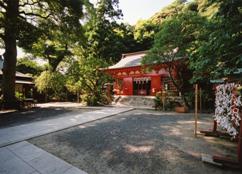
Egara Tenjin Shrine was founded in 1104, and have been revered as "God of Poetry" and "God that ensures "samurai pledges " along with Tsuruagoka Hachimangu. There is "Honden (Main Hall)" in the compound constructed in the 14thcentury, which was moved and rebuilt from Tsurugaoka Hachimangu Shrine in the 17thcentury.
Cultural properties designated by the national government (Historic sites/buildings)
- The compound of Egara Tenjinsha Shrine-(Historic site)
- Honden Main Hall of Egara Tenjinsha Shrine-(Important cultural property/buildings)
Access : Take a bus from JR Kamakura Station, get off at “Tenjin-mae” bus stop, and walk about 1 min.
(3)Jufukuji Temple
Jufukuji Temple is the first Zen Temple in Kamakura which was constructed in 1200. Buddhist Priest called "Eisai" was invited for the founding of the temple. Eisai introduced tea drinking habit and Zen Buddhism to Japan. This temple was built on the site of the residence of "Minamoto-no-Yoshitomo" (Yoritomo's father).
Cultural property designated by the national government (Historic site)
- The compound of Jufukuji Temple
Access : Approx.15 min.-walk from JR Kamakura Station
(4)Kenchoji Temple
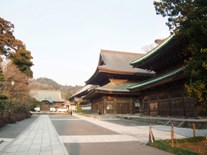
Kenchoji Temple is the first full-scale Zen Training monastery in Japan founded by the 5th regent Hojo Tokiyori in 1253. It is also an important temple which became the base to accept Chinese culture and spread Zen in Japan. In the compound, there are important cultural properties such as wooden architecture of "Butsuden Buddhist sanctum", "Sanmon temple gate", "Hatto main hall", "Shodo hall", and "Karamon gate" and places of scenic beauty such as early Zen gardens of Hojo-ura garden and Nakaniwa garden.
Cultural properties designated by the national government (Historic sites)
- The compound of Kenchoji Temple
- The garden of Kenchoji Temple - (Scenic beauty/historic site)
Important cultural properties designated by the national government (Buildings)
- Sanmon Temple Gate of Kenchoji Temple
- Butsuden Buddhist Sanctum of Kenchoji Temple
- Hatto Main Hall of Kenchoji Temple
- Karamon Gate of Kenchoji Temple
- Shodo Hall of Kenchoji Temple
- Daikakuzenjito Tombstone of Kenchoji Temple
Access : Approx.15 min.-walk from JR Kita-Kamakura Station
(5) Engakuji Temple
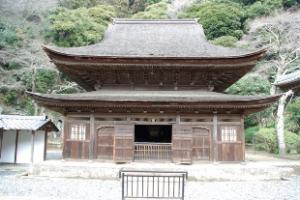
Engakuji Temple was a Zen training monestery built by the eighth regent Hojo Tokimune in 1282 to pray for the victims of the invasion by Mongolia without distinguishing friends and enemies. Also, it was one of the most important Zen Buddhist temple as the base to accept Chinese culture and contributed to spreading of Zen in Japan along with Kenchoji Temple. In the compound, there are Shariden hall (national treasure/masterpiece of Zen Buddhism architecture) and a garden designated as a place of scenic beauty.
Cultural properties designated by the national government (Historic sites/scenic beauty/buildings)
- The compound of Engakuji Temple - (Historic site)
- The garden of Engakuji Temple - ( Scenic beauty/historic site)
- Shariden Reliquary Hall of Engakuji Temple - (National treasure/buildings)
Access : Approx.1min.-walk from JR Kita-Kamakura Station
(6) Zuisenji Temple
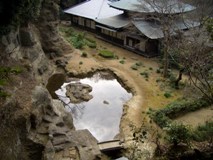
Zuisenji Temple is a Zen temple which was founded in 1327 by Muso Soseki. The garden is a national site of scenic beauty and also famous as an early Zen Buddhist garden.
Cultural properties designated by the national government (Historic sites/scenic beauty)
- The compound of Zuisenji Temple - (Historic site)
- The garden of Zuisenji Temple - (Scenic beauty)
Access : Take a bus from JR Kamakura Station, get off at “Daito-nomiya”, and walk about 2 min.
(7) Daibutsu (Great Buddha) of Kamakura
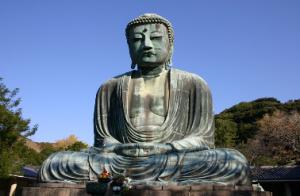
This historical site which has the 11.5m-high, bronze seated statue of "Amida-butsu "(national treasure) and "Daibutsuden" hall site. These properties are now part of Kotoku-in Temple. The "Daibutsu of Kamakura" kept its figure from the time of its construction approximately 750 years ago. The Buddha's magnificence and strength represent the samurai culture.
Cultural properties designated by the national government (Historic sites/carvings)
- The Remains of "Daibutsuden" Hall
- Bronze Seated Statue of "Daibutsu" -(National treasure/carvings)
Access : Approx.15 min.-walk from Hase Station of Enoden Line
(8) Kakuonji Temple
Kakuonji Temple was built by the ninth regent Hojo Sadatoki in 1296 after the two Mongolian attacks, when the society still had a sense of fear for another attack. Kakuonji Temple was built for the purpose to pray for the surrender of foreign enemies.
Two large stone pagodas, "Kaizanto" and "Daitoto" stands at the deepest spot in the compound, and Buddhist rites are held in front of them. These two pagodas are still revered as the center of the sanctuary of Kakuonji Temple.
●Cultural properties designated by the national government (Historic sites/buildings)
- The compound of Kakuonji Temple - (Historic site)
- Kaizanto Buddhist Pagoda of Kakuonji Temple - (Important cultural property/buildings)
- Daitoto Buddhist Pagoda of Kakuonji Temple - (Important cultural property/buildings)
Access : Take a bus from "JR Kamakura Station", get off at the terminal “Daito-nomiya”, and walk about 15 min.
(9) Jokomyoji Temple
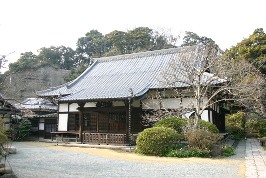
This temple was built by the wishes of the 5th regent Hojo Tokiyori and 6th regent Hojo Nagatoki in 1252. Jokomyoji Temple played the central role in the study of Buddhist teachings in Kamakura. The landform and allotment of land at the time still remains. "Hokyointo", a Japanese pagoda traditionally known as the tomb of Reizei Tamesuke is located here. Reizei, who came from Kyoto and became the center of the poets'society in Kamakura, represents a fusion of aristocratic culture and samurai culture in Kamakura.
Cultural property designated by the national government (Historic site)
- The compound and Reizei Tamesuke’s tomb in Jokomyoji Temple
Access : Approx.20 min.-walk from JR Kamakura Station
(10) Gokurakuji Temple
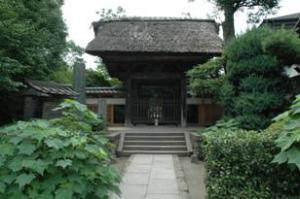
It was founded in 1259 by Hojo Shigetoki and the first chief priest was Ninsho. Ninsho dedicated his life to social work, such as helping the poor and the sick people. Ninsho's tomb pagoda, "Ninshoto" ("Gorinto"; important cultural property) is located here.
Cultural properties designated by the national government (Historic sites/building)
- The compound/Ninsho's Tomb of Gokurakuji Temple - (Historic site)
- Ninshoto Tomb Pagoda of Gokurakuji Temple - (Important cultural property/building)
Access : Approx.1min.-walk from Hase Station of Enoden Line
(11) Shomyoji Temple
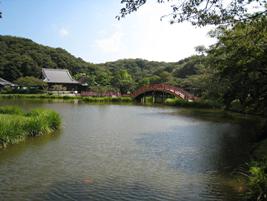
Shomyoji Temple was established in 1259, by the Kanazawa Hojo clan, that had their house in an important area with “Mutsuranotsu”, the outer harbor of Kamakura. Shomyoji played a key role in defense of Kamakura and establishment/development of samurai culture. The greatest feature of Shomyoji is that it stores Kanazawa-Hojo clan's huge collection of books, are works, and ancient documents known as "Kanazawa Bunko Library". It is an indispensable place for us to learn about samurai culture and society.
Cultural property designated by the national government (Historic site)
- The compound of Shomyoji Temple
Access : Approx.15 min.-walk from Kanazawa-bunko Station of Keihin Kyuko Line
(12) Yofukuji Temple Site
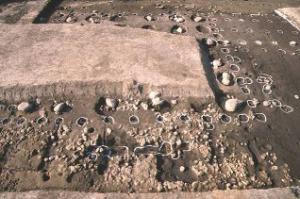
Yofukuji Temple was constructed by Minamoto-no-Yoritomo in 1189. This temple was built to pray for the enemy dead after defeating Oshu-Fujiwara clan. From the excavation findings, remains of the magnificent cathedral and the Pure Land garden, which modeled after Chusonji Temple's "Daichojuin hall" and Motsuji Temple's "Kondo hall", were discovered.
Cultural property designated by the national government (Historic site)
-Yofukuji Temple Site
Access : Take a bus from JR Kamakura Station, get off at the terminal of “Daito-nomiya”, and walk about 10 min.
(13) Hokkedo Buddha Hall Site
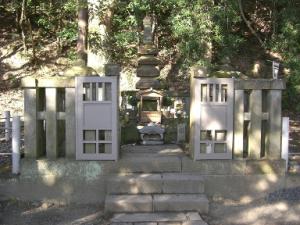
This place is where Hokkedo Buddha Halls of Minamoto-no-Yoritomo and the 2nd regent Hojo Yoshitoki were constructed. There are Minamoto-no-Yoritomo’s grave pagoda in the west and Hojo Yoshitoki’s Hokkedo Buddha hall site in the east under the ground.
Cultural property designated by the national government (Historic site)
- Hokkedo Buddha Hall Site (Minamoto-no-Yoritomo’s tomb/Hojo Yoshitoki’s tomb)
Map of Hokkedo Buddha Hall Site
Access : Approx.20 min.-walk from JR Kamakura Station
(14) Toshoji Temple Site
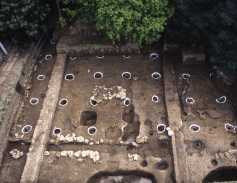
Toshoji Temple was constructed by the 3rd regent Hojo Yasutoki in the early 13thcentury. This place was the stage of downfall of the Kamakura Shogunate. The Hojo clan committed mass suicide by their swords at Nitta Yoshisada’s attack in 1333. The temple does not remain because it was abolished at the end of the Middle Age, however, the remains of the buildings are well preserved under the ground.
Cultural property designated by the national government (Historic site)
- Toshoji Temple Site
Access : Approx.15 min.-walk from JR Kamakura Station
(15) Buppoji Temple Site
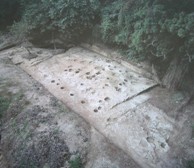
The remains of Gokurakuji Temple's branch offer a full view of Kamakura's seacoast which was under the control of Gokurakuji Temple in Kamakura Period. They were one of strategic points of transportation which strengthen defense of the west entrance of Kamakura. This place was an important base of the battles over Kamakura in 1333.
Cultural property designated by the national government (Historic site)
- Buppoji Temple Site
Access : This site is not open to the public at the moment.
(16) Hojo Tokiwa Residence Site
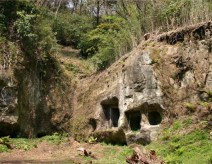
This place is considered as a site of the 7th regent Hojo Masamura's residence. It is a good example of housing land developed on the low ground of the valley. It was a defense point of Daibutsu Kiridoshi Pass. The site shows the life of Kamakura samurai very well.
Cultural property designated by the national government (Historic site)
- Hojo Tokiwa Residence Site
Map of Hojo Tokiwa Residence Site
Access : Approx.15 min.-walk from JR Kamakura Station
(17) Wakaenoshima Port
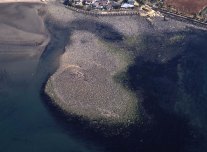
In 1232, Wakaenoshima port was constructed as part of development plan of the seat of government for the purpose of securing safety of the docking ships. It is the oldest extant harbor construction site on reclaimed land in Japan.
Cultural property designated by the national government (Historic site)
- Wakaenoshima Port
Access : Take a bus for “Zushi Station” from Kamakura Station (or a bus for “Kamakura Station” from Zushi/Shin-Zushi Station), get off at “Iijima”, and walk about 1 min.
(18) Kiridoshi Pass
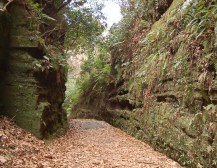
During early 13th century, the government started to make passes as part of the development plan of the government. These passes called "Kiridoshi", were the land traffic routes and the defensive base of Kamakura during war. Mountain ridge was vertically dug down to make a valley, whose floor was made into a pass.
The land around "Kiridoshi" was utilized in various ways, such as funeral facilities like "Yagura"(tombs) caves, execution places and markets.
"Yagura" ---> Yagura caves (holes dug into the side of a hill) are tombs made during the Middle Ages in Kamakura. Yagura caves are found clustered around the slope in the hilly area.
Cultural properties designated by the national government (Historic sites)
Access :
[From Yokohama City side] Take a bus for “Kamakura Station” from Kanazawa Hakkei Station of Keihin Kyuko Line, (There are other buses available), get off at “Asahina”bus stop, and walk about 10 min.
[From Kamakura City side] Take a bus for “Kanazawa Hakkei Station” (or for “Kamakura Reien Seimon-mae Tachiarai” ) from Kamakura Station, get off at “Juniso Jinja” bus stop, and walk about 10 min.
Access :
[From Zushi City side] Take a bus for Kamegaoka Danchi Junkan” from Zushi/Shin-Zushi Stations, get off at “Kamegaoka Danchi Kita” bus stop, and walk about 5 min.
[From Kamakura City side] Take a bus for “Shin-Zushi Station” from Kamakura Station, get off at “Midorigaoka Iriguchi” bus stop, and walk about 10 min.
Access : Approx.15 min.-walk from JR Kita-Kamakura Station
Access : Approx.30 min.-walk from JR Kamakura Station. Near "Genjiyama Koen Park".
Map of Daibutsu Kiridoshi Pass
Access : Approx.15min.-walk from Hase Station of Enoden Line
このページに関するお問い合わせ先
このページの所管所属は教育局 生涯学習部文化遺産課です。